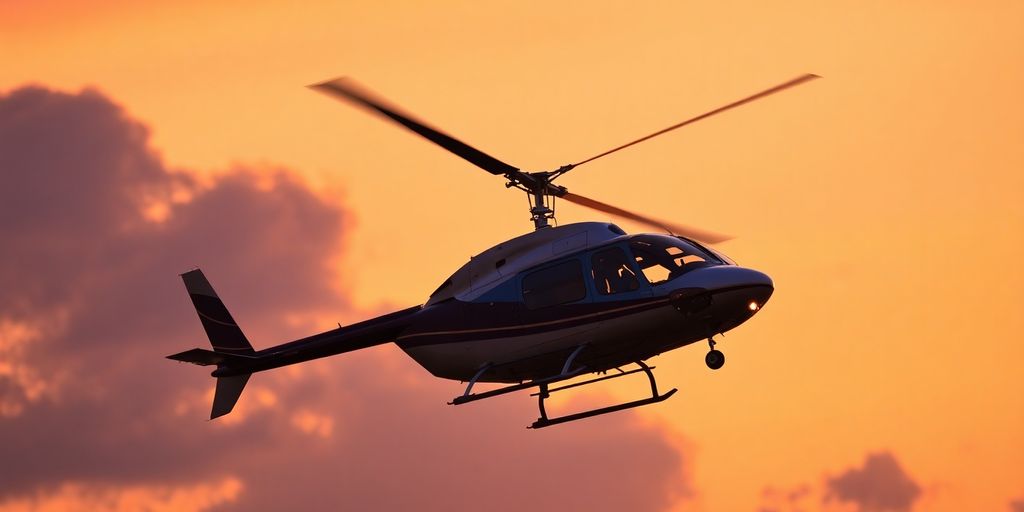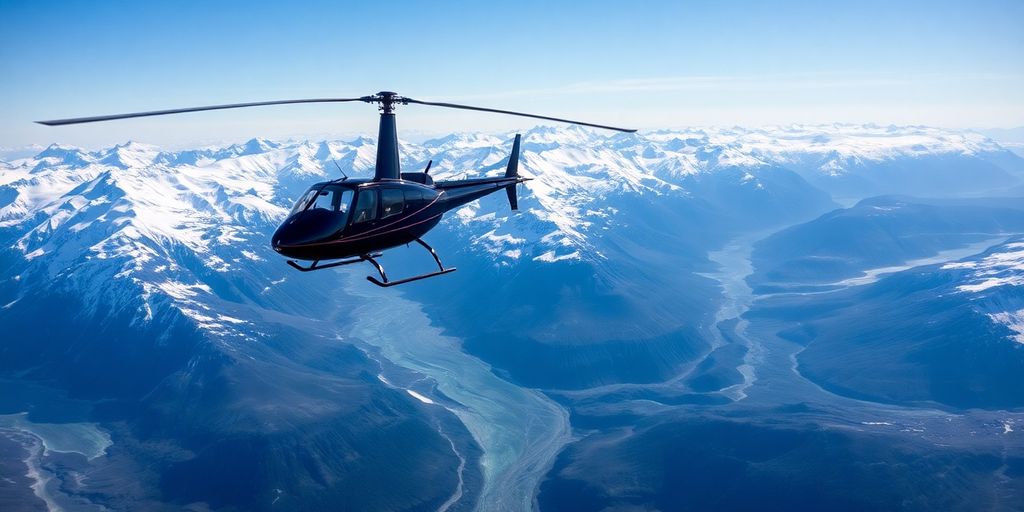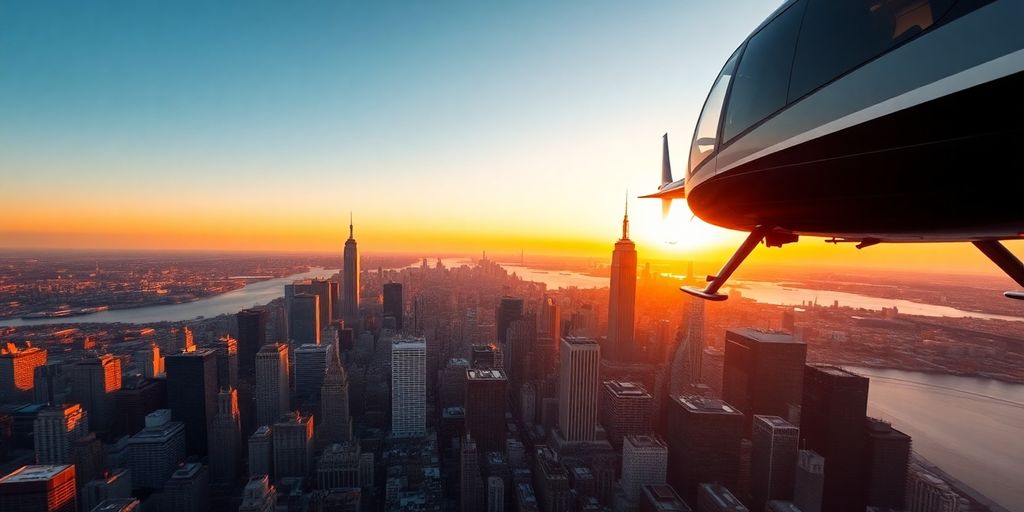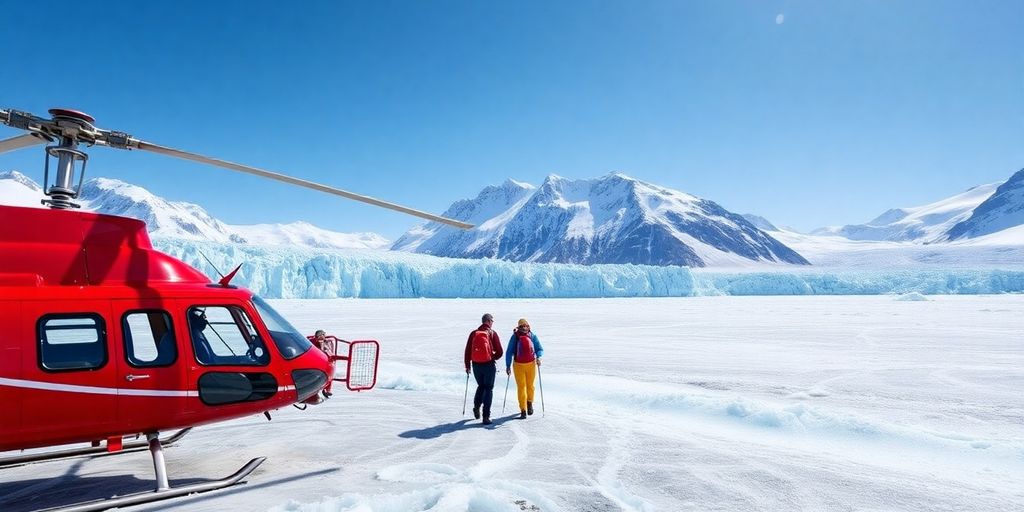Hey there, helicopter enthusiasts! 2025 is an exciting year for rotorcraft lovers. With so many new models and tech advancements, picking the right chopper can be a bit overwhelming. Whether you’re looking for luxury, performance, or just a reliable ride, there’s something out there for everyone. In this guide, we’ll explore some of the best helicopters of the year and help you figure out which one suits your needs best. Let’s dive in and see what makes these flying machines tick!
Want to see what modern helicopters are really made for? At Heli Alaska, we offer unforgettable Alaska helicopter tours with glacier landings, scenic views, and expert pilots.
Key Takeaways
- Electric and hybrid helicopters are gaining popularity for their eco-friendly benefits.
- Advanced rotor designs are improving flight efficiency and safety.
- AI and automation are becoming integral in modern helicopter navigation systems.
- Luxury models like the Hill HX50 and Bell 525 offer top-tier comfort and performance.
- Sustainability is a growing focus, with many helicopters using recyclable materials and energy-efficient systems.
Understanding the Evolution of Helicopter Technology
The Rise of Electric and Hybrid Models
In recent years, there’s been a significant shift towards greener aviation solutions, and helicopters are no exception. The push for electric and hybrid models is driven by the need to reduce carbon emissions and improve efficiency. Imagine a helicopter that operates quietly, reducing noise pollution—it’s not just a concept anymore. Companies are actively developing electric propulsion systems, which promise to transform the industry. These advancements could make helicopter travel more sustainable and accessible, opening up a new era in aviation.
Advancements in Rotor Design
Helicopter rotor design has come a long way from its early days. Modern advancements focus on improving efficiency and reducing noise. One of the most significant developments is the introduction of composite materials, making rotors lighter and more durable. These materials allow for greater flexibility in rotor design, enabling helicopters to perform better in various conditions. Innovations like the NOTAR (No Tail Rotor) system are being explored to enhance safety and reduce noise pollution. This system offers a quieter and safer alternative to traditional tail rotors, which is a big deal for urban operations.
AI and Automation in Aviation
Artificial Intelligence (AI) is making waves in helicopter navigation systems. AI technologies are being integrated to assist pilots with decision-making and to improve flight safety. Imagine a helicopter that can analyze weather conditions and suggest optimal flight paths or one that can automatically adjust its course to avoid obstacles. AI systems can also monitor the helicopter’s health, predicting maintenance needs before they become critical issues. This integration is a game-changer for both commercial and military operations, offering enhanced situational awareness and operational efficiency.
Top Helicopter Models for Private Use in 2025
The Hill HX50 is setting new standards in the private helicopter market. With its sleek, aerodynamic design and powerful 500 shp engine, this helicopter offers a cruise speed of 140 knots and a range of 700 nautical miles. The interior is fully customizable, providing a luxurious experience for those who prioritize comfort and style. Whether you’re flying for business or pleasure, the HX50 combines performance and elegance, making it a top choice for private owners.
Key Features:
- 500 shp engine ensuring robust performance.
- Cruise speed of 140 knots.
- Range of 700 nautical miles.
- Customizable interior for luxury and comfort.
The Bell 525, also known as “Relentless,” is a standout in the luxury helicopter segment. Designed for both corporate and private use, it features an advanced cockpit with state-of-the-art avionics. The cabin layout is flexible, accommodating various seating configurations, which makes it ideal for business meetings or leisure travel. With its high payload capacity and extended range, the Bell 525 is perfect for those who require both luxury and functionality.
Key Features:
- Advanced cockpit with modern avionics.
- Flexible cabin layout for different seating needs.
- Smooth ride for both short and long distances.
- High payload capacity and extended range.
The Robinson R44 is a favorite among private owners, known for its affordability and reliability. It can accommodate up to four passengers and reaches a maximum speed of 149 mph with a range of 348 miles. Its versatility makes it suitable for personal transport, sightseeing, and pilot training. The R44 continues to be a cornerstone in the private helicopter market due to its cost-effectiveness and dependable performance.
Key Features:
- Seats up to four passengers.
- Maximum speed of 149 mph.
- Range of 348 miles.
- Cost-effective and reliable.
In 2025, private helicopters are more accessible and diverse than ever, offering a range of options that cater to different needs and budgets. Whether it’s the luxurious Hill HX50, the versatile Bell 525, or the reliable Robinson R44, there’s a helicopter out there for every type of private owner. Choosing the right model depends on your specific requirements and lifestyle.
Key Criteria for Selecting the Best Helicopter

Intended Use: Business or Leisure
When you’re picking out a helicopter, the first thing to nail down is what you plan to use it for. Are you flying for business or pleasure? This choice can really shape your decision. Business flyers might lean towards models that offer a balance of speed and efficiency. Leisure users, on the other hand, may be more interested in comfort and the overall flying experience.
Range and Endurance Considerations
Think about how far you need to travel and how long you want to stay in the air. Helicopter range and endurance can vary a lot. Some models are built for short hops, while others can handle longer distances without needing to refuel. Knowing your flight needs helps in picking a model that won’t leave you stranded halfway to your destination.
Passenger Capacity and Comfort
How many people do you expect to fly with? This is a biggie. Helicopters come in all shapes and sizes, and you’ll want one that fits your group comfortably. Look for configurations that offer not just enough seats, but also a comfy ride. Legroom, seat quality, and even window size can make a big difference in passenger satisfaction.
Picking the right helicopter is like choosing the right tool for a job. It’s all about matching the machine to your needs and making sure it fits your lifestyle.
Balancing Cost and Performance in Helicopter Selection
When picking a helicopter, finding the right balance between cost and performance is like walking a tightrope. You don’t want to blow your budget on bells and whistles you don’t need, but you also don’t want to miss out on essential features.
Understanding Operating Costs
Operating a helicopter isn’t just about the upfront price tag. You’ve got to factor in the ongoing expenses like maintenance, insurance, and fuel. These costs can add up quickly, so it’s crucial to consider them when planning your budget. Keep in mind that travel expenses, including airfare, are expected to rise, which could impact your overall costs.
Evaluating Long-term Maintenance
Maintenance isn’t just a one-time thing; it’s a long-term commitment. Regular upkeep is vital to keep your helicopter running smoothly and safely. The global helicopter MRO market is projected to grow, highlighting the importance of staying on top of maintenance. Think about the expanding market for maintenance services when assessing long-term costs.
Single-engine vs. Multi-engine Options
Choosing between single-engine and twin-engine helicopters can be a tough call. Single-engine models are generally more affordable and simpler to maintain, making them suitable for straightforward routes. On the flip side, twin-engine helicopters offer more power and speed, which can be a game-changer in challenging conditions. Weigh the pros and cons to see which option fits your needs best.
Ultimately, selecting the right helicopter boils down to understanding your needs and matching them with the right features. It’s not just about the specs; it’s about ensuring your helicopter meets your specific requirements safely and efficiently.
Safety Features to Look for in Modern Helicopters

Autorotation Capabilities
Autorotation is a lifesaver when it comes to helicopter safety. Imagine you’re flying and suddenly, the engine decides to quit on you. Scary, right? But with autorotation, the rotor blades keep spinning, even without engine power, thanks to the airflow moving upwards through the rotor. This allows the helicopter to glide down and land safely. It’s like having a parachute for the entire aircraft. This feature is crucial for emergency landings, giving pilots a controlled way to bring the helicopter down without power.
Health & Usage Monitoring Systems
Think of Health & Usage Monitoring Systems (HUMS) as the helicopter’s own personal doctor. These systems are constantly checking the helicopter’s vital signs, like vibrations and engine performance. If something’s off, HUMS will alert the operators before it turns into a big problem. This not only boosts safety but also helps cut down on maintenance costs. So, you get a helicopter that’s not just safer but also cheaper to run in the long haul.
Crash-resistant Fuel Systems
Crash-resistant fuel systems are all about minimizing risks during accidents. They’re designed to prevent fuel leaks, which significantly reduces the chance of a fire after a crash. These systems use special materials and designs that are less likely to rupture on impact. For passengers and crew, this means more peace of mind every time they fly. It’s like having an extra layer of protection that you hope you’ll never need, but you’re glad it’s there if you do.
Helicopter safety has seen big improvements over the years. With features like autorotation and crash-resistant systems, modern helicopters are better equipped to handle unexpected situations. Being prepared with the right tools can make all the difference in ensuring a safe flight.
Exploring the Market for Used Helicopters
Inspection Tips for Buyers
When you’re in the market for a used helicopter, thorough inspections are a must. Start with the exterior—check for any signs of damage or corrosion. Pay close attention to the rotor blades and tail rotor; any cracks or excessive wear could mean costly repairs down the line. Inside, ensure all instruments and avionics are functioning properly. If the systems are outdated, you might need expensive upgrades. It’s always wise to hire a professional for a pre-buy inspection to catch any hidden issues.
Popular Models and Their Features
There are several models that stand out in the used helicopter market. The Robinson R44 is favored for its affordability and reliability. The Bell 206 is known for its versatility and performance, while the Airbus H125 offers more capacity. Each model comes with its own set of features, so it’s beneficial to do a side-by-side comparison to see which one fits your needs best.
Market Trends and Pricing Insights
The market for used helicopters can be unpredictable. Lately, there’s been a downward trend in asking prices for pre-owned aircraft. This could be a great time to discover top helicopters available for purchase if you’re hunting for a deal. However, lower prices might also mean higher demand, so it’s a balancing act. Keep an eye on inventory trends and pricing insights to make an informed decision. It’s all about timing and knowing when to make your move.
Buying a used helicopter is a big decision, but with the right research and a clear understanding of the market, you can find a great deal that suits your needs. Just remember to weigh all the factors and don’t rush into anything.
Sustainability and Eco-friendly Helicopter Designs
Use of Recyclable Materials
In recent years, the helicopter industry has taken significant strides towards sustainability by incorporating recyclable materials into their designs. Manufacturers are increasingly using components that can be repurposed or recycled at the end of their lifecycle, reducing waste and conserving resources. This shift not only minimizes the environmental impact but also aligns with the broader global effort to promote a circular economy. For instance, the use of lightweight materials not only aids in fuel efficiency but also ensures that parts are easier to recycle.
Energy-efficient Systems
Energy efficiency is at the forefront of modern helicopter design. By integrating advanced propulsion systems, such as electric and hybrid engines, helicopters are becoming more fuel-efficient and environmentally friendly. These systems significantly cut down on greenhouse gas emissions and lower operational costs. The development of sustainable aviation fuel further complements these efforts, offering a greener alternative to traditional jet fuel. Energy-efficient helicopters not only benefit the environment but also provide a cost-effective solution for operators.
Solar-powered Innovations
Solar power is emerging as a promising avenue for eco-friendly helicopter design. While still in its nascent stages, the integration of solar panels into helicopter structures offers the potential for harnessing renewable energy. This innovation could lead to longer flight times and reduced dependency on fossil fuels. Although full-scale implementation is a work in progress, the prospect of solar-powered flight represents a significant step towards a sustainable aviation future.
The journey towards greener skies is not just about reducing emissions; it’s about reimagining the way helicopters are built and operated. With each innovation, the industry moves closer to a future where sustainability and efficiency go hand in hand.
As the helicopter industry continues to evolve, initiatives like the revolutionizing measurement of environmental impact are crucial in guiding sustainable practices. These efforts, alongside strategic agreements like the one between Crisalion Mobility and Copenhagen Helicopter, underscore the commitment to a cleaner, more sustainable aviation landscape. Looking to the future, advancements in aviation technology will continue to drive the industry towards greener horizons.
Technological Innovations Enhancing Flight Experience

Gyro Stabilization and Altitude Hold
Flying a helicopter is no small feat, but with gyro stabilization and altitude hold, things get a lot smoother. These technologies make sure the helicopter stays steady, even when the weather isn’t playing nice. Gyro stabilization helps keep the helicopter balanced, while altitude hold maintains a steady height. This means pilots can focus more on enjoying the flight rather than wrestling with the controls. It’s like having a co-pilot who never gets tired.
AI-assisted Navigation
Artificial intelligence is changing the game in helicopter navigation. Imagine a helicopter that can suggest the best route based on weather and air traffic. That’s what AI-assisted navigation is all about. It helps pilots make smarter decisions by providing real-time data and suggestions. Plus, it can even predict maintenance needs, keeping the helicopter in top shape. With AI on board, flying becomes a whole lot safer and more efficient.
User-friendly Control Systems
Today’s helicopters come with control systems that are easier to use than ever before. Touchscreens, intuitive controls, and smart interfaces make flying accessible even for beginners. These systems simplify the pilot’s job, reducing the learning curve and making flying more enjoyable. Whether you’re a seasoned pilot or just starting out, user-friendly controls mean less stress and more fun in the sky.
As technology keeps advancing, flying helicopters is becoming more intuitive and enjoyable, opening up new possibilities for all kinds of pilots.
The Future of Helicopter Types and Their Applications

Autonomous Helicopters in Agriculture
The agricultural sector is on the brink of a transformation with the advent of autonomous helicopters. These flying machines can perform a variety of tasks such as crop monitoring, spraying, and even planting. Imagine a fleet of drones working tirelessly over vast fields, each equipped with sensors and AI to make real-time decisions. This kind of automation not only increases efficiency but also reduces the need for human labor in challenging environments. The potential for precision agriculture is enormous, offering farmers a way to increase yields while minimizing resource use.
Helicopters for Search and Rescue
In the world of search and rescue, helicopters have always been indispensable. But now, with the integration of cutting-edge technology, their role is expanding. Equipped with thermal imaging, GPS, and even autonomous capabilities, modern helicopters can locate missing persons faster and more accurately than ever before. In life-or-death situations, these advancements can make all the difference. The ability to deploy quickly and operate in difficult conditions makes helicopters an essential tool for emergency services worldwide.
Luxury Helicopters for VIP Transport
Luxury helicopters are no longer just a means of transport; they are a statement of prestige and comfort. The latest models offer plush interiors, advanced entertainment systems, and unparalleled privacy. For the elite, traveling by helicopter is not just about getting from point A to B, but about doing so in style. With the rise of 2025 helicopter prices and models, there’s a growing demand for bespoke designs that cater to the unique tastes and preferences of VIP clients. Whether it’s for business or leisure, these flying palaces offer an experience that is both exclusive and unforgettable.
As we look to the future, helicopters are poised to become more versatile than ever. From revolutionizing agriculture to enhancing rescue missions and providing luxury travel options, their applications are as varied as they are vital.
As we look ahead, the world of helicopters is evolving rapidly, with new designs and uses emerging every day. From search and rescue missions to thrilling adventure tours, helicopters are becoming more versatile than ever. For an unforgettable real-world experience in Alaska’s skies, check out our Alaska helicopter tours — complete with glacier landings and breathtaking views.
Wrapping Up Our Helicopter Journey
So, there you have it, folks. We’ve taken a good look at some of the top helicopters of 2025. Whether you’re a newbie just getting into the hobby or a seasoned pilot looking for the next best thing, there’s something out there for everyone. These flying machines have come a long way, offering more features and better performance than ever before. But remember, it’s not just about the specs. Think about what you want to do with your helicopter. Is it for fun, or are you planning to get serious with competitions? Whatever your goal, make sure to pick a model that fits your needs and budget. And hey, don’t forget to have fun while you’re at it. After all, that’s what flying is all about, right? Happy flying!
If reading about these helicopters has you dreaming of being in the sky, why not make it real? Whether it’s your first ride or your fiftieth, there’s nothing like flying over Alaska’s glaciers and mountains. Explore our tours and turn inspiration into adventure.
Frequently Asked Questions
What makes helicopters different from airplanes?
Helicopters can take off and land vertically, hover in place, and fly in any direction, unlike airplanes that need runways.
How do helicopters stay in the air?
Helicopters use rotating blades to create lift, allowing them to hover and move in different directions.
Are helicopters safe to fly?
Yes, helicopters are safe when maintained properly and flown by trained pilots. They have safety features like autorotation for emergencies.
What can helicopters be used for?
Helicopters are used for many things, like rescue missions, transporting people, sightseeing, and even filming movies.
How much does a helicopter cost?
The cost of a helicopter can vary a lot. It can be from hundreds of thousands to millions of dollars, depending on the model and features.
Can anyone learn to fly a helicopter?
Yes, with proper training and dedication, most people can learn to fly a helicopter. It requires a special pilot’s license.
What is the difference between a single-engine and a multi-engine helicopter?
A single-engine helicopter has one engine and is usually cheaper and lighter. A multi-engine helicopter has two or more engines, offering more power and safety.
How do helicopters help in emergencies?
Helicopters can quickly reach remote areas, provide medical transport, and assist in search and rescue operations.


